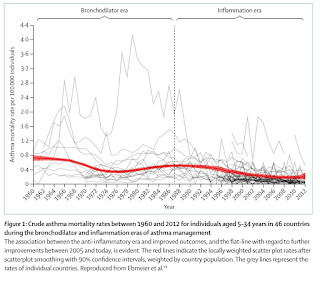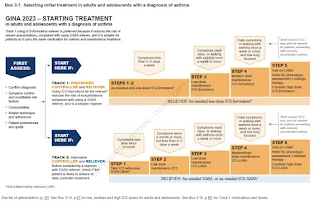Asthma
Introduction
Asthma is a chronic inflammatory disorder of the airways with bronchial hyperresponsiveness producing symptoms related to limited airflow that can be reversed.
- Respiratory symptoms (e.g. wheeze, shortness of breath, cough, chest tightness) vary over time.
The diagnosis of allergic asthma is more likely when the person also has allergy and a family history of asthma.
Management
The long-term goals of asthma management are risk reduction and symptom control.
- The aim is to reduce the burden to the patient and to reduce their risk of asthma-related death, exacerbations, airway damage and medication-side effects.
Good asthma control is having, in the previous 4 weeks:
- Daytime symptoms <2 days a week
- Need for reliver <2 days a week (excluding doses for preventing exercise-induced bronchoconstriction
- No limitation of activity
- No symptoms during the night or on waking.
Identify and manage trigger factors, e.g. cigarette smoke, allergens, irritant, certain drugs or food, infections or comorbidities.
Assess inhaler techniques and adherence.
Influenza and pneumococcal vaccinations should be considered in patients with severe asthma, although evidence of benefit is lacking.
GINA 2023
In year 2019, there is a major change in the GINA strategy report in asthma management. For safety reasons, GINA no longer recommends treatment with short-acting beta2-agonist (SABA) alone, without inhaled corticosteroids.
- Although SABA provides quick relief of symptoms, SABA-only treatment is associated with increased risk of exacerbation and lower lung function.
On the other hand, all adults and adolescents with asthma should receive inhaled corticosteroid (ICS)-containing controller treatment. The treatment options for mild asthma are:
- As-needed low dose ICS-formoterol (preferred due to simplicity), or
- Regular low dose ICS plus as-needed SABA.


Comments
Post a Comment